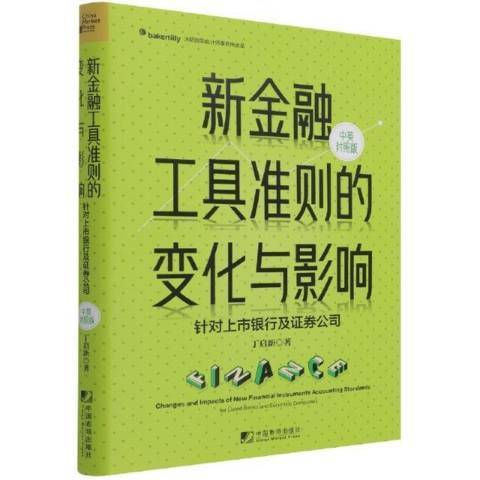內容簡介
全面解讀新金融工具準則的新變化與新規定以及對金融企業的影響
新金融工具準則對上市銀行的影響
通過對51家上市銀行財務報表的列報及披露進行研究,分析和歸納了新金融工具準則對上市銀行金融資產分類與計量的實際影響。以上市銀行的貸款業務和投資業務作為實施新金融工具準則的觀察對象,以轉換日的金融資產分類結果研究為基礎,對轉換日後兩到三年的財務報表進行了追蹤分析,評價了新金融工具準則實施後上市銀行的金融資產分類結構的變化情況。
新金融工具準則對上市證券公司的影響
通過對38家上市證券公司財務報表的列報及披露進行研究,分析和歸納了新金融工具準則對上市證券公司金融資產分類與計量的實際影響。以上市證券公司的信用業務和自營業務作為實施新金融工具準則的觀察對象,以轉換日的金融資產分類結果研究為基礎,對轉換日後兩到三年的財務報表進行了追蹤分析,評價了新金融工具準則實施後上市證券公司金融資產分類結構的變化情況。
圖書目錄
第1章 導 論
1.1 新金融工具準則出台的背景和研究意義
1.1.1 出台背景
1.1.2 研究意義
1.2 國內外研究現狀及文獻綜述
1.2.1 國內研究現狀及文獻綜述
1.2.2 國外研究現狀及文獻綜述
1.3 研究內容、研究思路和研究方法
1.3.1 研究內容
1.3.2 研究思路
1.3.3 研究方法
第2章 新金融工具準則的主要內容及變化
2.1 金融工具分類與計量的變化
2.1.1 新舊準則下金融工具分類與計量的變化
2.1.2 金融資產重分類的變化
2.1.3 金融負債分類與計量的變化
2.2 金融工具減值的變化
2.2.1 新舊金融工具減值模型的對比
2.2.2 金融工具減值範圍的變化
2.3 嵌入衍生工具會計處理的變化
2.4 金融資產轉移和終止確認的變化
2.5 套期會計適用性的變化
2.6 金融工具列報的變化
2.6.1 資產負債表的變化
2.6.2 利潤表的變化
2.6.3 所有者權益變動表的變化
第3章 新金融工具準則在上市銀行的套用與影響分析
3.1 新金融工具準則對上市銀行金融資產分類的影響分析
3.1.1 信貸業務的分類情況分析
3.1.2 投資業務的分類情況分析
3.1.3 新舊準則下金融資產分類的變化分析
3.1.4 新金融工具準則轉換日後金融資產分類的變化分析
3.2 金融資產減值情況分析
3.2.1 轉換日減值情況分析
3.2.2 貸款階段劃分情況分析
3.2.3 貸款減值準備情況分析
3.2.4 金融投資減值準備情況分析
3.2.5 與貸款減值相關會計估計技術的披露
3.3 新金融工具準則實施對上市銀行淨資產的影響
3.4 新金融工具準則實施對上市銀行利潤表的影響
3.4.1 利潤表結構分析
3.4.2 以攤余成本計量的金融資產終止確認收益變動分析
3.5 新金融工具準則實施對上市銀行業務開展的影響
第4章 新金融工具準則在上市證券公司的套用與影響分析
4.1 新金融工具準則對上市證券公司金融資產分類的影響分析
4.1.1 新舊準則下金融資產分類的變化分析
4.1.2 新金融工具準則轉換日後金融資產分類的變化分析
4.2 新金融工具準則對上市證券公司金融資產投資減值的影響分析
4.2.1 新金融工具準則對上市證券公司金融資產投資減值的影響分析——融出資金
4.2.2 新金融工具準則對上市證券公司金融資產投資減值的影響分析——買入返售金融資產
4.2.3 新金融工具準則對上市證券公司金融資產投資減值的影響分析——應收款項
4.2.4 新金融工具準則對上市證券公司金融資產投資減值的影響分析——債權投資
4.2.5 新金融工具準則對上市證券公司金融資產投資減值的影響分析——其他債權投資
4.2.6 新金融工具準則下金融資產減值階段劃分標準
4.2.7 與減值相關會計估計技術的披露
4.3 新金融工具準則對上市證券公司估值變化的影響分析
4.3.1 新舊準則下金融工具估值範圍的變化
4.3.2 新金融工具準則轉換日對上市證券公司估值調整的分析
4.4 上市證券公司新舊金融工具準則轉換對淨資產的影響
4.5 新金融工具準則對上市證券公司利潤表的影響
4.5.1 利潤表結構分析
4.5.2 以攤余成本計量的金融資產終止確認收益變動分析
4.6 新金融工具準則對上市證券公司管理模式的影響
第5章 新金融工具準則對財務報表影響的研究總結
參考文獻
Chapter 1 Introduction
1.1 Research Background and Significance
1.1.1 Research Background
1.1.2 Research Significance
1.2 Research Status and Literature Review at Home and Abroad
1.2.1 Domestic Research Status and Literature Review
1.2.2 Overseas Research Status and Literature Review
1.3 Research Content, Research Thought and Research Method
1.3.1 Research Content
1.3.2 Research Thought
1.3.3 Research Method
Chapter 2 Main Contents and Changes in New Financial Instruments Standards
2.1 Changes in the Classification and Measurement of Financial Instruments
2.1.1 Changes in the Classification and Measurement of Financial Instruments under the Old and New Financial Instruments Standards
2.1.2 Changes in the Reclassification of Financial Assets
2.1.3 Changes in the Classification and Measurement of Financial Liabilities
2.2 Changes in Impairment of Financial Instruments
2.2.1 Comparison of Impairment Models for Old and New Financial Instruments
2.2.2 Changes in the Scope of Impairment of Financial Instruments
2.3 Changes in Accounting Treatment for Embedded Derivatives
2.4 Changes in Transfer and Derecognition of Financial Assets
2.5 Changes in the Applicability of Hedge Accounting
2.6 Changes in the Presentation of Financial Instruments
2.6.1 Changes in Balance Sheet
2.6.2 Changes in Income Statement
2.6.3 Changes in Statement of Change in Equity
Chapter 3 Application and Impact Analysis of New Financial Instruments Standards in Listed Banks
3.1 Impact Analysis of the New Financial Instruments Standards on the Classification of Financial Assets of Listed Banks
3.1.1 Analysis of the Classification of Credit Business
3.1.2 Analysis of the Classification of Investments
3.1.3 Analysis of Changes in the Classification of Financial Assets under the Old and New Financial Instruments Standards
3.1.4 Analysis of the Changes of the Classification of Financial Assets after the Transition Date of New Financial Instruments Standards
3.2 Analysis of Impairment of Financial Assets
3.2.1 Analysis of Impairment at the Date of Transition
3.2.2 Analysis of Loan Stage Division
3.2.3 Analysis of Loan Impairment Provisions
3.2.4 Analysis of Financial Investments Impairment Provisions
3.2.5 Disclosure of Accounting Estimation Techniques Related to Loan Impairment
3.3 Impact of the Implementation of the New Financial Instruments Standards on the Net Assets of Listed Banks
3.4 Impact of the Implementation of the New Financial Instruments Standards on the Income Statement of Listed Banks
3.4.1 Analysis of Income Statement Structure
3.4.2 Analysis of Changes in Income from Derecognition of Financial Assets Measured at Amortized Cost
3.5 Impact of the Implementation of the New Financial Instruments Standards on the Business Development of Listed Banks
Chapter 4 Application and Influence Analysis of New Financial Instruments Standards in Listed Securities Companies
4.1 Analysis of the Impact of the New Financial Instruments Standards on the Classification of Financial Assets Investments in Listed Securities Companies
4.1.1 Analysis of Changes in the Classification of Financial Assets under the Old and New Financial Instruments Standards
4.1.2 Analysis of Changes of the Classification of Financial Assets after Transition Date of the New Financial Instruments Standards
4.2 Impact Analysis of the New Financial Instruments Standards on the Impairment of Financial Assets Investments in Listed Securities Companies
4.2.1 Impact Analysis of New Financial Instruments Standards on the Impairment of Financial Assets Investments of Listed Securities Companies—Margin Accounts Receivable
4.2.2 Impact Analysis of New Financial Instruments Standards on the Impairment of Financial Assets Investments of Listed Securities Companies—Redemptory Monetary Capitals for Sale
4.2.3 Impact Analysis of New Financial Instruments Standards on the Impairment of Financial Assets Investments of Listed Securities Companies—Receivables
4.2.4 Impact Analysis of New Financial Instruments Standards on the Impairment of Financial Assets Investments of Listed Securities Companies—Debt Investments
4.2.5 Impact Analysis of New Financial Instruments Standards on the Impairment of Financial Assets Investments of Listed Securities Companies—Other Debt Investments
4.2.6 Division Standard of the Impairment Stage of Financial Assets under the New Financial Instruments Standards
4.2.7 Disclosure of Accounting Estimation Techniques Related to Impairment
4.3 Impact Analysis of the New Financial Instruments Standards on Valuation Changes of Listed Securities Companies
4.3.1 Changes in the Scope of Financial Instruments Valuation under the Old and New Financial Instruments Standards
4.3.2 Analysis of Valuation Adjustments for Listed Securities Companies at the Transition Date to the New Financial Instruments Standards
4.4 Impact of the Transition into New Financial Instruments Standards on Net Assets of Listed Securities Companies
4.5 Impact of the Implementation of the New Financial Instruments Standards on the Income Statement of Listed Securities Companies
4.5.1 Analysis of the Structure of the Income Statement
4.5.2 Analysis of the Change of Termination Recognition Income of Financial Assets Measured by Amortized Costs
4.6 Impact of the New Financial Instruments Standards on the Business and Management Model of Listed Securities Companies
Chapter 5 Research Summary
References
作者簡介
丁啟新
天職國際會計師事務所金融服務業務主管合伙人,上海財經大學會計學碩士,中國註冊會計師,英國特許公認會計師,財政部國際化高端會計人才。
從事金融機構審計和諮詢工作近20年,曾服務多家國內外大型金融機構,對金融機構業務、金融工具準則、保險契約準則等有較深的理解與研究。
天職國際會計師事務所
天職國際會計師事務所成立於1988年,是早取得證券、期貨業務資質的會計師事務所之一。歷經30餘年的成長,已成為中國知名的綜合性會計師事務所。天職國際以服務央企和金融機構為特色,採用高度集中型一體化管理模式,按專業分工設定部門、按地域布局設立分所,人力資源、執業標準和利益分配完全統一,在中國註冊會計師協會評選的“全國百強會計師事務所”中位列前十。

